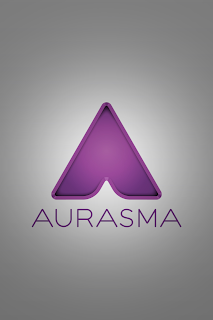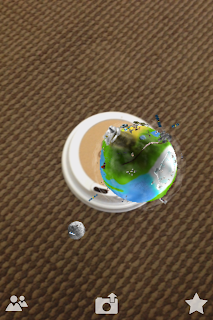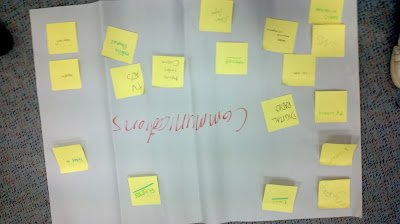My Cross-Media Experience :
This experience of Cross-Media was a brand new experience to me. Although I'm a graphic designer, I had some experience in the advertising world and got to work on "guerilla" and "alternative" marketing projects, the Transmedia Storyworld was a first.
It was a little hard for me to understand the whole transmedia storyworld through an engaged audience process, it was all very confusing to me since I also had to adapt to the Australian accent, but by viewing some examples and inspiration, I ended up being pretty clear.
After reading the briefing "How Might We use Cross-media to inspire a culture of sustainability on the UC Campus" I already knew I would target the students. I had to find a storyworld they could recognise themselves into, and participate in, something that would be close to their own storyworld. So Uyen Tran and myself formed a group and together, we create our character. We had the same overall idea but our two characters evolved quite differently in their own storyworld, which I think is very interesting.
The Character :
So our character is a douchebag. And mine is called Nate (got the name inspired from my real life frequentations). Nate is a architecture student at UC in his 3rd year. He is 22 years old and he believes he's incredible and amazing. Of course this is far from the truth.
Nate is self centred and totally irresponsable, all he loves to talk about is parties, girls and sports. A classic student douchebag.
Without quite realising it, Nate is a bad character, but because of his attitude, he helps people realise their own and ends up making some good around him, hopefully !
Nate will have to work on a assignment about sustainability, but he would hate it, intentionally botch it. When he realises it's imperative that he passes this unit, he will have to interview people, do research and learn about sustainability, green buildings and environmental issues. Nate would have all the bad attitudes regarding sustainability and that's when I hope it will have an impact on the audiance.
They would realise they might have the same attitude and would have to change their actions.
Indeed, during my research on sustainability during the tutorials, I realised that the first step to a more sustainable world is first to make people realise what they are doing is wrong. It's showing them the impact of their actions that would make them change, so I hope that is what is going to be the reaction when watching Douchebag Nate.
The Audience:
I truly believe that Douchebag Nate is a character that UC students can relate to : First of all he's also a student, that has assignments and classes, so their storyworld would match and the could interact. Also, Nate would not just be a pain in the a**, he would also be funny and sometimes sweet, but mainly a jerk.
The audience will be following Douchebag Nate thanks to the many rabbitholes and advertisement on campus. He would be active on two platforms mainly : Facebook and Youtube. Of course youtube would be the platform where we would post the videos and there will be areas to comment and the audience will be able to subscribe to the channel.
The second platform will be Facebook. There, the audience will be able to follows Nate's every move. He will post live statuses on his activites, post pictures, and the audience can interact by asking his questions, dare him to do all kinds of things and decide on his future actions. He would also be available on intagram, twitter. After a while, some t-shirt will be distributed with Nate's quotes to make his popularity increase.
The Platforms :
About the Facebook Page, I got 3 likes on my page (it think) by posting a poster on the UC campus, (People from UC I don't know) others are just people from the same unit.
Here is the poster I created :
I placed it in 3 different places in campus :
- The architecture area in building 7
- The refectory doors
- The entrance doors of building 9
I also had happened to walk by it when people where looking at it and laughing, but they didn't bother to go any further. At least I got some attention.
Once you liked the faceboook page, I put some basic content for people to like and interact. Some links to videos and a couple of Nate's statuses. I put a link to a question, I put on a picture of Nate playing Beer Pong, and I also interacted with other characters that I found out about during the tutorials :
Franco the Fair Trade Farmer
I also interacted with Daniel the Dead Tasmanian Tiger, which was pretty fun :
I think the best content I have on facebook is just the frequency of the posts. Stupid posts, just the kind of stuff that makes Douchebag Nate's Storyworld.
I particularly liked the instagram picture Nate posted :
About the Youtube Page, I think the best I have is the 1min trailer I shot to introduce the Web Series. It's basically showing what to expect on the first season of Douchebag Nate without saying too much.
-> Douchebag Nate Trailer <-
To make my audience surf from one platform to another, I simply use links on my facebook page to my youtube page, and liks from my Youtube to my facebook ! Pretty simple on those two platforms to make them connect.
On the Youtube channel, the fan will be able to see all the videos from the webseries posted, he will be able to comment them, like them, share them, then he will be able to visit Douchebag Nate's facebook page to find all the additional content : Nate's impressions, "behind the scenes" footage, react, ask questions, tell his opinion, decide of the character's future and more !
For now on my two platforms the audience knows Nate is a architecture student that has a assignment and that's it's a real douchebag. They will have to wait to see more !
Experimentations :
Since I launched my Douchebag Nate to the real world, i've learned some interesting things about the subject. First of all, since I'm not a media student, I never did any "real" project that got as far as this one. In general if I have a marketing idea I just present it into slides but never experienced it for real.
I realised it's very difficult to make people care about your project. It was hard for me to engage people and ask them for feedback since I was not used to this kind of work. I felt really uncomfortable while shooting because I didn't know how people would react. For the rabbithole, I realised how hard it is to grab their attention since they only go on with their own routine, never getting any interest in something new. I thing my "Douchebag Nate" title might have captured the attention of some since it's quite unusual, but without more inerest.
I realise if I want to make this project work I will need to put a lot of effort into getting an audience, after that It's the easier part about the story flow and making it happend.
I also realised it's very hard to keep the people interested, they have to have a reason to stay, that's why I need to make my transmedia as wide and flourished as possible.
So to wrap up I would say that next time I would definitely try to engage my audience way more effectively and once I have their attention try to provide them with the best content possible.
If I ever had funding to make it happend, I would gather a group of the best camera crew and make a memorable pilot episode. And I would spend that money into creating events that would develop my character into the story : Parties, Sport events, etc...
The Conclusion:
To conclude with my work overall, I would say that I succeeded into answering the briefing. I'm pretty sure that people would change their attitude if they had seen what Douchebag Nate did to the poor future generations... My character is effective and promising, I just needed to dig deeper into the actual media that I need to provide.
Most importantly, it changed my own behaviour for sure. Not only about being more sustainable, but it made me realise how much we can achieve if everybody just changed tiny simple things in life : from turning the heater down to building green buildings. My research in the area made me realise some things that I will change in my life for now on.





























